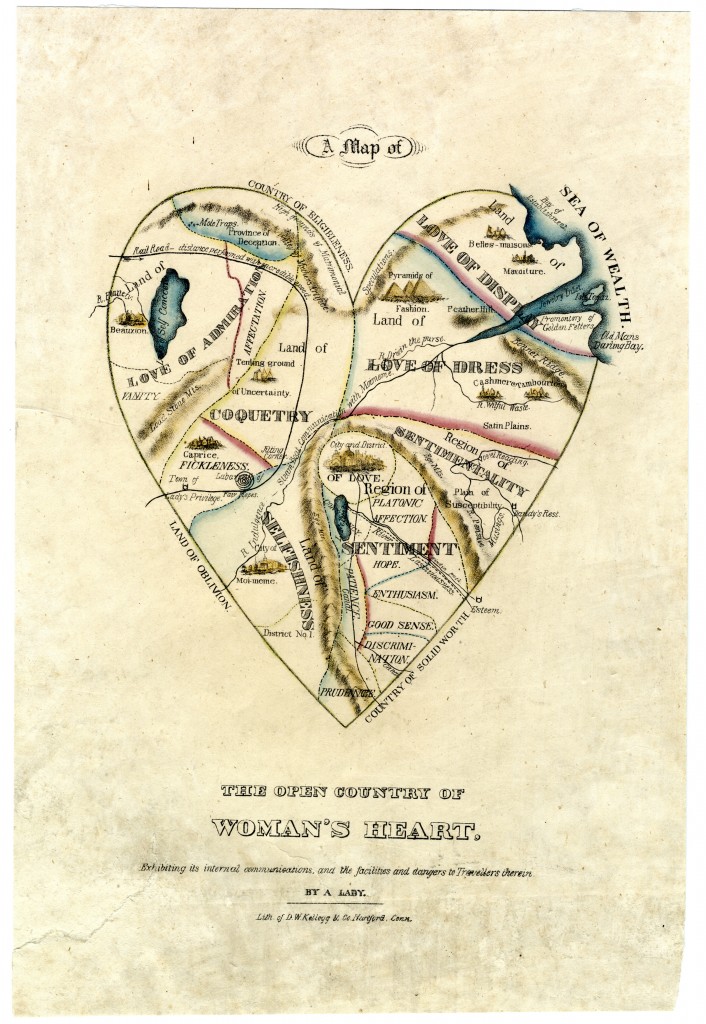 It’s an age-old question: What is the way to a woman’s heart? (It’s also a timely question, with Mother’s Day this coming weekend.) We often hear the way to a man’s heart is food, beer, or sports. To a woman’s, it’s usually said that it’s chocolate, jewelry, clothing, or shoes. If we dig a little deeper, men may also value kindness and compassion, women sensitivity and strength. These are all stereotypes, of course, but one striking thing about working in an archive is reaffirming that there really is nothing new under the sun, including stereotypes—and the tiny bits of truth they sometimes hold.
It’s an age-old question: What is the way to a woman’s heart? (It’s also a timely question, with Mother’s Day this coming weekend.) We often hear the way to a man’s heart is food, beer, or sports. To a woman’s, it’s usually said that it’s chocolate, jewelry, clothing, or shoes. If we dig a little deeper, men may also value kindness and compassion, women sensitivity and strength. These are all stereotypes, of course, but one striking thing about working in an archive is reaffirming that there really is nothing new under the sun, including stereotypes—and the tiny bits of truth they sometimes hold.
Among the thousands of images depicting women in our collections, there is one that has continually sparked discussion whenever we share it with K-12 and Hands-On History Workshop participants: A Map of the Open Country of Woman’s Heart, Exhibiting its internal communication, and the facilities and dangers to Travellers therein. Printed between 1833 and 1842 with attribution stated as “By a Lady,” this image serves as a perfect place to begin exploring nineteenth-century ideas about and attitudes towards women. At first glance, its complex layout and soft, pretty colors lead the viewer to think they are looking at a positive and glowing depiction of women’s love and understanding. Closer viewing belies these initial signals, revealing that the Lands of Love of Admiration, Love of Display, Love of Dress, Coquetry, and Selfishness take up far more space in a woman’s heart than the Region of Sentiment, which consists of districts such as Love, Hope, Enthusiasm, Good Sense, and Patience.
While I certainly take issue with the creator’s proportions of positive versus negative traits, closer inspection of these so-called lands and regions does bring to mind some present-day assumptions about human 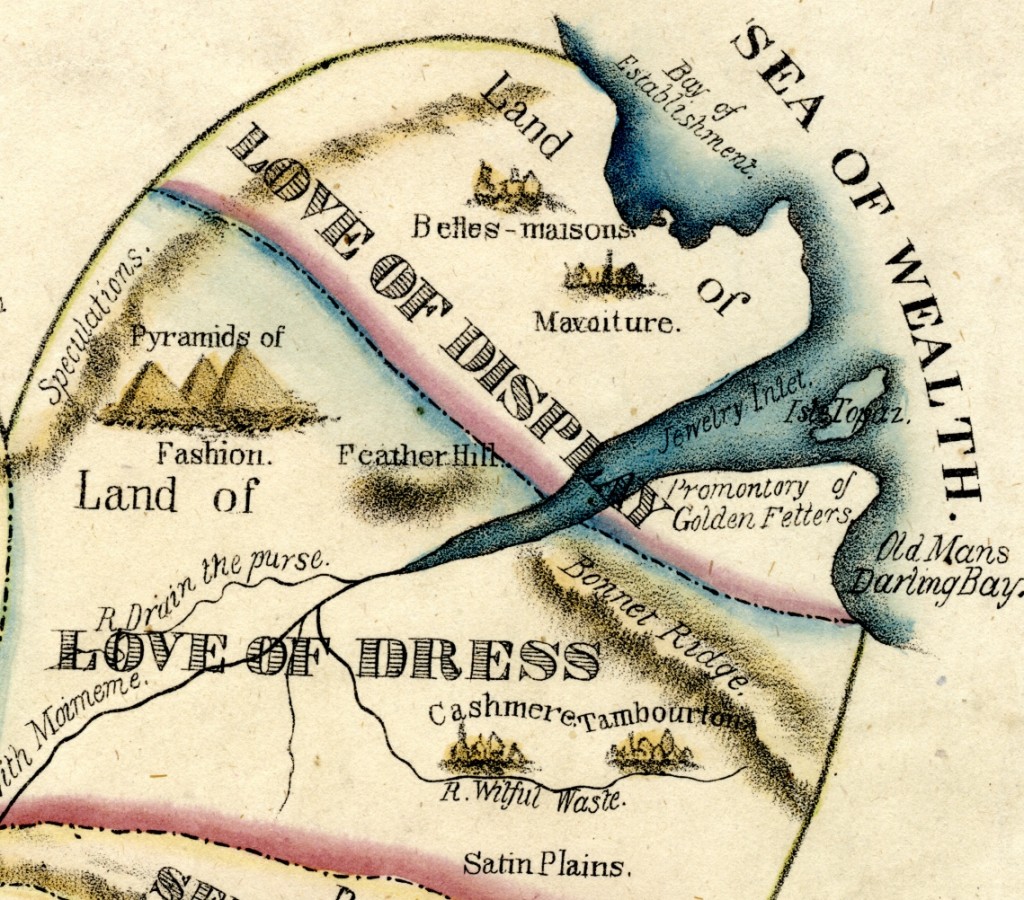 (and woman) nature. For example, apparently jewelry and clothing have always been seen as one way to a woman’s heart. If you look closely at the Lands of Love of Dress and Display in the top right of the heart, they include the cities of Cashmere and Belles-maisons (“Beautiful-houses”); the Satin Plains; the Pyramids of Fashion; Bonnet Ridge; and the Rivers Drain the Purse and Wilful Waste, both of which flow into the Jewelry Inlet. The creator has left no doubt about their attitudes toward a love of fashion and style, even bordering these lands with the Bays of Establishment and Old Mans Darling. By these standards, some women today—including myself, who can never pass up a good pair of shoes—are certainly guilty of a love of dress and display.
(and woman) nature. For example, apparently jewelry and clothing have always been seen as one way to a woman’s heart. If you look closely at the Lands of Love of Dress and Display in the top right of the heart, they include the cities of Cashmere and Belles-maisons (“Beautiful-houses”); the Satin Plains; the Pyramids of Fashion; Bonnet Ridge; and the Rivers Drain the Purse and Wilful Waste, both of which flow into the Jewelry Inlet. The creator has left no doubt about their attitudes toward a love of fashion and style, even bordering these lands with the Bays of Establishment and Old Mans Darling. By these standards, some women today—including myself, who can never pass up a good pair of shoes—are certainly guilty of a love of dress and display.
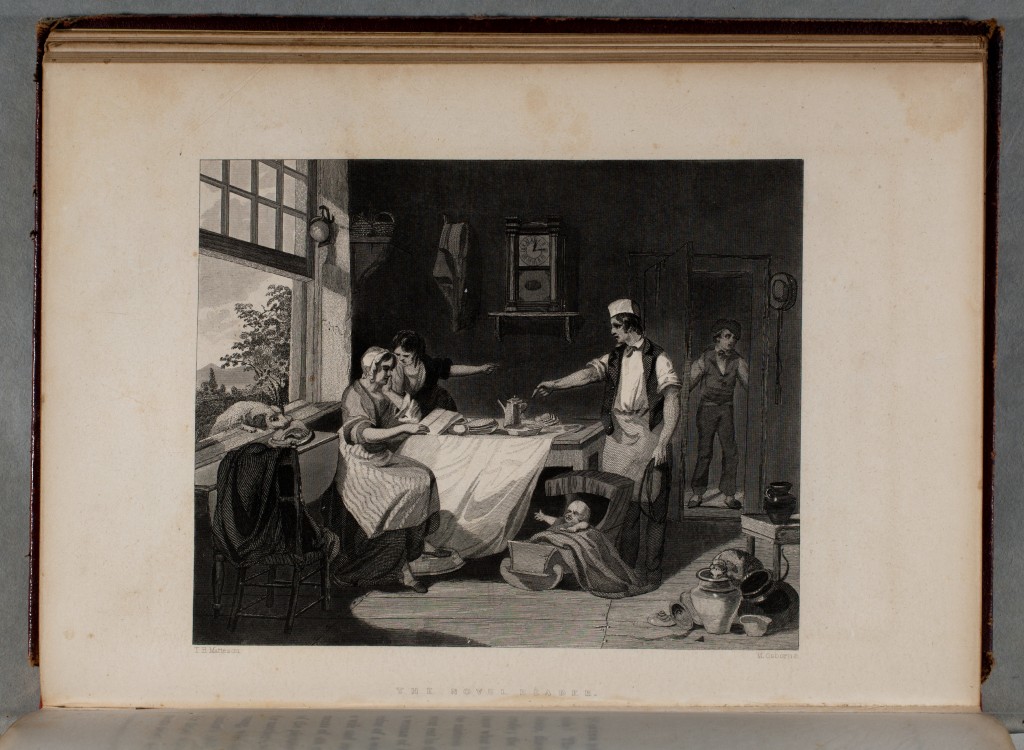
Many of the other lands include similar negative topographical names. Even the Land of Sentimentality—a concept that was very popularly applied to women in the nineteenth century—features the Plain of Susceptibility and the town of Dandy’s Rest, the idea presumably being that if you are too sentimental you are susceptible to being taken in, making you perfect prey for those vain dandies. Let’s also not forget the damaging influence of the ultimate conveyor of sentimentality, the novel. A Land of Sentimentality would not be complete without a River of Novel Reading.
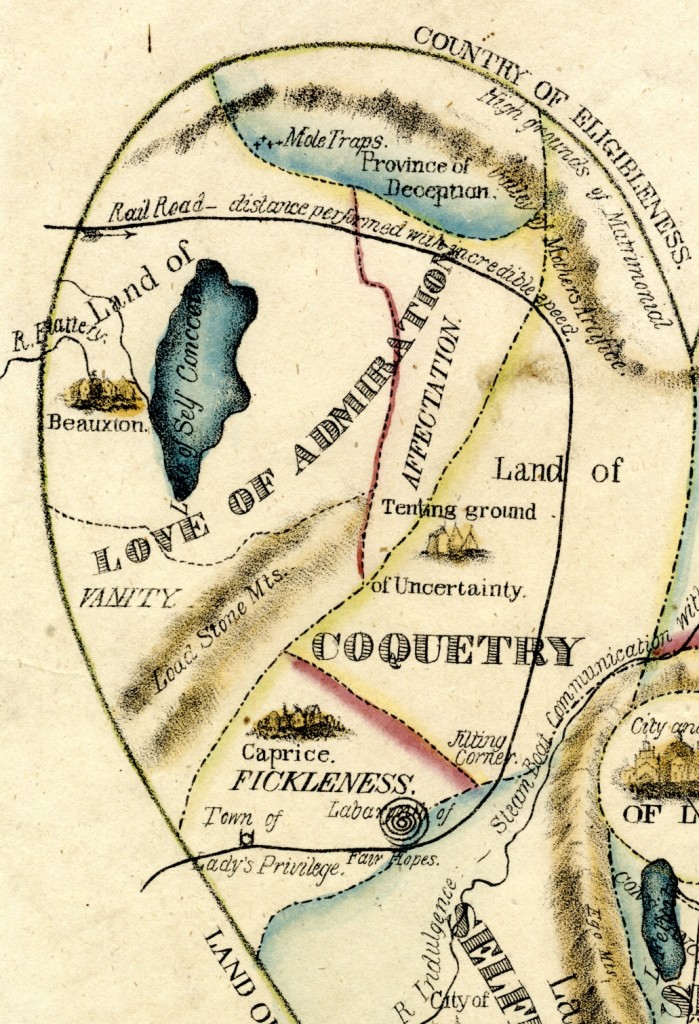 Aside from these topographical elements, however, one of the most interesting aspects of this image is the use of what was at the time either relatively or very new transportation technology to convey a sense of women’s patterns of emotion and behavior. Take, for example, the railroad, which begins in the top left corner in the Land of Love of Admiration and covers distance “with incredible speed.” It moves through this first land, past the Lake of Self Concern, the High Grounds of Matrimonial Speculations, and the Valley of Mothers Artifice, and into the Land of Coquetry. From there it speeds past the Tenting ground of Uncertainty, through Jilting Corner, briefly finds itself in the Land of Selfishness where it passes the Labarynth of Fair Hopes, and on through the Town of Lady’s Privilege in the Region of Fickleness, finally crossing the border into the Land of Oblivion. Following this path gives one the impression of a whirlwind tour of the plot of one of those nineteenth-century sentimental novels the creator finds so distasteful, or else reeks of the bitterness of someone who has fallen prey to a woman’s (and her mother’s) prospective matrimonial games one to many times. Perhaps someone had been reading a too few many of those novels themselves.
Aside from these topographical elements, however, one of the most interesting aspects of this image is the use of what was at the time either relatively or very new transportation technology to convey a sense of women’s patterns of emotion and behavior. Take, for example, the railroad, which begins in the top left corner in the Land of Love of Admiration and covers distance “with incredible speed.” It moves through this first land, past the Lake of Self Concern, the High Grounds of Matrimonial Speculations, and the Valley of Mothers Artifice, and into the Land of Coquetry. From there it speeds past the Tenting ground of Uncertainty, through Jilting Corner, briefly finds itself in the Land of Selfishness where it passes the Labarynth of Fair Hopes, and on through the Town of Lady’s Privilege in the Region of Fickleness, finally crossing the border into the Land of Oblivion. Following this path gives one the impression of a whirlwind tour of the plot of one of those nineteenth-century sentimental novels the creator finds so distasteful, or else reeks of the bitterness of someone who has fallen prey to a woman’s (and her mother’s) prospective matrimonial games one to many times. Perhaps someone had been reading a too few many of those novels themselves.
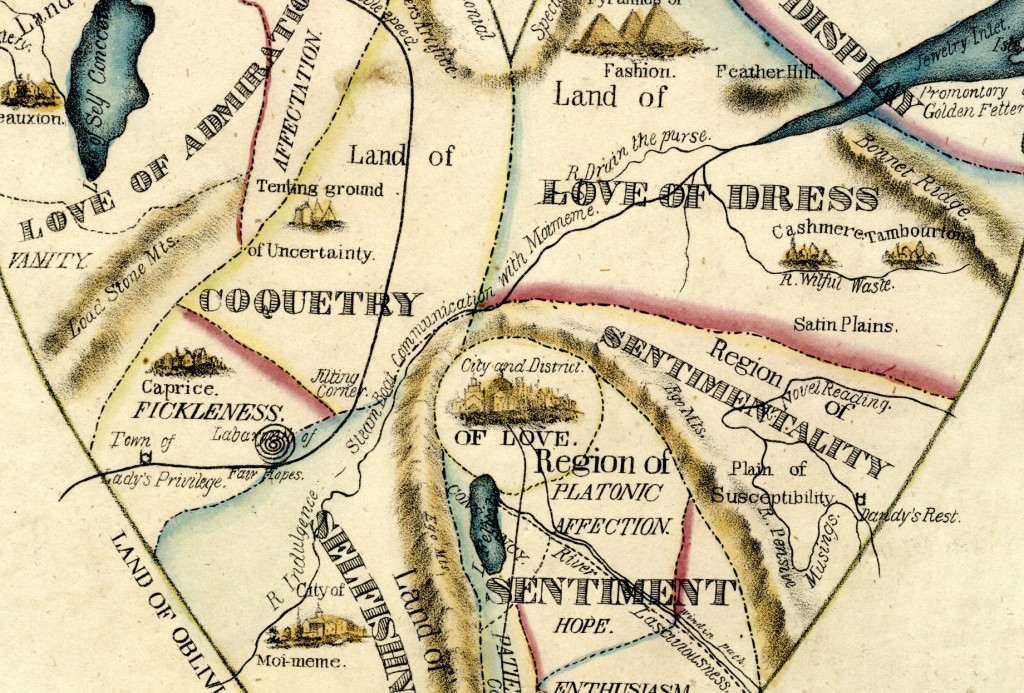 The employment of the transportation metaphor shows up again with the steamboat on the River of Indulgence, which provides communication between the City of Moi-meme (“Myself”) in the Land of Selfishness and the Lands of Love of Dress and Display on the opposite end of the country. The metaphor of a steamboat—a form of transportation that was relatively quick and could travel lengthy distances, but was not quite as efficient as a railroad—gives one the sense that it is not a far trip from selfishness to vanity. Indeed, rather than the windswept sense of love affairs the railroad gives, the connection between selfishness and vanity is more constant and steady.
The employment of the transportation metaphor shows up again with the steamboat on the River of Indulgence, which provides communication between the City of Moi-meme (“Myself”) in the Land of Selfishness and the Lands of Love of Dress and Display on the opposite end of the country. The metaphor of a steamboat—a form of transportation that was relatively quick and could travel lengthy distances, but was not quite as efficient as a railroad—gives one the sense that it is not a far trip from selfishness to vanity. Indeed, rather than the windswept sense of love affairs the railroad gives, the connection between selfishness and vanity is more constant and steady.
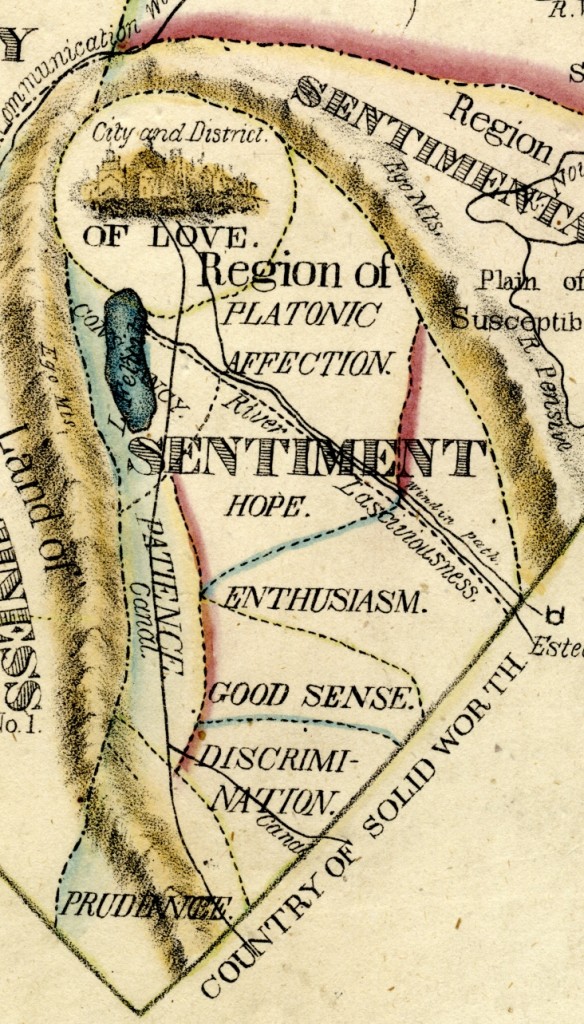 Before we get too angry with the artist, there are a few good traits depicted—a very few. Right at the heart of the heart is the City and District of Love. As mentioned earlier, this Region of Sentiment includes qualities such as patience, prudence, and hope. Within this small region, protected (to keep people in or out?) by the Ego Mountains, reside the final, as well as the slowest and oldest, forms of transportation included on the map. The Canal and the Windin Path, which begin in the Country of Solid Worth, are the only two routes that lead into the City and District of Love. Both are short and slow methods of travel, suggesting that to enter that golden city, one needs patience, steadiness, and reliability. A woman’s love is worth taking the time and effort to acquire. (What the River of Lasciviousness, connecting the Country of Solid Worth and the Lake of Felicity, is doing in this region is less clear.)
Before we get too angry with the artist, there are a few good traits depicted—a very few. Right at the heart of the heart is the City and District of Love. As mentioned earlier, this Region of Sentiment includes qualities such as patience, prudence, and hope. Within this small region, protected (to keep people in or out?) by the Ego Mountains, reside the final, as well as the slowest and oldest, forms of transportation included on the map. The Canal and the Windin Path, which begin in the Country of Solid Worth, are the only two routes that lead into the City and District of Love. Both are short and slow methods of travel, suggesting that to enter that golden city, one needs patience, steadiness, and reliability. A woman’s love is worth taking the time and effort to acquire. (What the River of Lasciviousness, connecting the Country of Solid Worth and the Lake of Felicity, is doing in this region is less clear.)
With all this said, the question remains: Was this designed by a man or a woman? Sure, it states it’s “By a Lady,” but as with nineteenth-century authorship, that does not necessarily mean it’s so. Is the image reflecting nineteenth-century male stereotypes about women? Or was someone trying to send a message to her fellow women? In any case, I hope you’re planning a nice gift for your mother this weekend. Some jewelry or a novel would be much appreciated, I’m sure.
